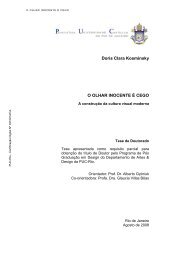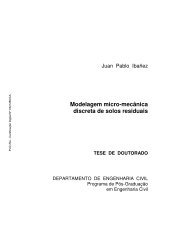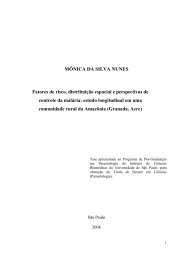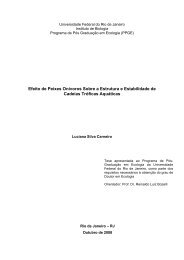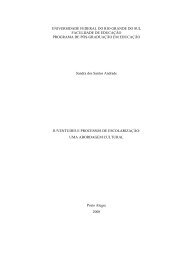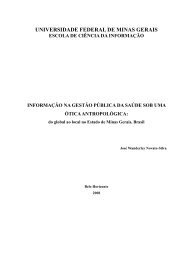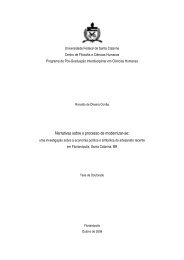D.A.R. Magalhães et al. / Molecular Immunology 42 (2005) 1043–1048 1047mice, encompassing a previous analysis of the <strong>gene</strong>s whichwere only differentially expressed (Cluster and Tree-Viewmethod), and a second analysis clustering only those <strong>gene</strong>swhich were differentially and significantly expressed (SAMand Cluster and Tree-View methods).By exploring a large set of <strong>gene</strong>s, we intended to identifynovel differentially expressed <strong>gene</strong>s that could be used asmarkers for the individual stages of thymus ontogeny.However, the clustering of raw expression data using theset of 1,261 <strong>gene</strong>s caused a shuffling among RNA samples(cDNA probes) from each day of gestation (Fig. 2).Considering the possibility that the similarity betweensamples from two distant days of gestation, such as 14 and 17days p.c., as seen in the dendrogram of Fig. 2, might not bestatistically significant, we applied a second round of clustering,now using the differentially and significantly expressed<strong>gene</strong>s. Using this approach, it was possible to distinguish thedays of gestation (Fig. 3), demonstrating the importance, inthis study, of a previous statistical treatment instead of usingonly raw normalized microarray data to run the Cluster andTree-View method.Reclustering showed that the constitution of the <strong>gene</strong> clusterdiverged for each stage of thymus development, i.e. eachcluster harbored different <strong>gene</strong>s with different expression patterns.The 14th day p.c. RNA sample was considered to be thetest sample for comparisons with the subsequent days of gestation(14 versus 15, 14 versus 16 and 14 versus 17 days p.c.);however, in a given cluster, the repressed <strong>gene</strong>s in a given dayof gestation presented as induced on the following day. Thisis evidence that the <strong>gene</strong>s used for data reclustering may playa role in thymus ontogeny and may represent novel candidate<strong>gene</strong>s participating in the control of T-cell maturation.It was possible to point out seven <strong>gene</strong>s implicated incell signaling. The hematopoietic cell signal transducer <strong>gene</strong>,Hcst, (accession number NM011827, ID 640698) was inducedin the early stages of thymus development (14–16 daysp.c.) and repressed at 17 days p.c. The Hcst protein is locate<strong>do</strong>utside the plasma membrane and is implicated in thecoupling of receptor stimulation to <strong>do</strong>wnstream activation ofGTPases. As the maturation of the thymocytes within the thymusdepends on the participation of other cell types, such asstroma (Gill et al., 2003), this could represent evidence for arole of the Hcst <strong>gene</strong> in cellular communication via molecularsignaling in the early thymus.Genes implicated in the calcium signaling pathwaywere also modulated, such as the proline-rich Gla (Gcarboxyglutamicacid) polypeptide 2 <strong>gene</strong>, Prrg2, (accessionnumber NM022999, ID 640686), the Down syndromecritical region homolog 1 <strong>gene</strong>, Dscr1, (accession numberNM019466, ID 640638), and the syntaxin binding protein 3<strong>gene</strong>, Stxbp3, (accession number NM011504, ID 640484),whose proteins have a role in the inhibition of the calciuminflux pathway via calcineurin. These <strong>gene</strong>s were repressedin the early (15 days p.c.) and late (17 days p.c.) thymus. Thecasein kinase 1,alpha 1 <strong>gene</strong>, Csnk1a1 (accession numberTable 2Number of ESTs differentially expressed during thymus development of(Balb-c × C57Bl/6) F 1 hybrid mice as reported by the SAM program aThymus development(in days p.c.)Significant ESTsInducedRepressedFDR14–15 20 49 4814–16 10 30 2214–17 10 14 64a Complete file of ESTs available online (http://www.rge.fmrp.usp.br/passos/TRBV81/SAM/table2), FDR = false discovery rate (median).NM146087, ID 640022) whose protein is an inhibitor of calcineurin,was induced at 16 days p.c. These data, suggest thatthe calcium influx pathway could be activated in the thymuswith 15 and 17 days p.c. and <strong>do</strong>wn-regulated with 16 daysp.c.All these <strong>gene</strong>s above mentioned participates in the controlof calcium influx pathway mediated by calcineurin, which isimportant in the activation of the nuclear factor of activatedT-cells (NFAT), an transcription factor of T-cells.As calcium signaling is implicated in the induction of T-cell anergy mediated through calcineurin and NFAT, our resultscould be useful to know the <strong>gene</strong>s that induce tolerance(Feske et al., 2001, 2003; Heissmeyer et al., 2004).The Golgi SNAP receptor complex member 2 <strong>gene</strong>,Gosr2, (accession number NM019650, ID 640152) was inducedin the thymus from 15 to 17 days p.c. This <strong>gene</strong> hasa role in the intracellular transport of newly synthesized proteinsfrom the en<strong>do</strong>plasmic reticulum to their destination inthe cell. Since we showed in this study that T-cells within thethymus begin to mature from 14 days p.c., the activation ofthe Gosr2 <strong>gene</strong> in this phase is of particular importance dueto the necessity of delivering the T-cell receptors chains onthe cell surface.Finally, we have shown that the protein tyrosine phosphatase4a3 <strong>gene</strong>, Ptp4a3, (accession number NM008975,ID 640437), was induced in the thymus with 17 days p.c.There is evidence for a role of this <strong>gene</strong> in humans in colorectalcancer metastasis (Saha et al., 2001), i.e. cell migration.As the mature thymocytes should migrate from the thymus toblood stream, this may be evidence for the participation of thePtp4a3 <strong>gene</strong> in the late stages of T-cell maturation includingmigration from the thymus.The 133 EST sequences reclustered in the dendrogramsof Fig. 3, whose functions were not yet assigned,presented a differential pattern of expression andwere reclustered together with named <strong>gene</strong>s (Table 2)(www.rge.fmrp.usp.br/passos/TRBV81/SAM/table2). Thiscan be evidence for the participation of these ESTs in biologicalprocesses similar of those of the known <strong>gene</strong>s. TheseESTs are being studied by our group with the aim of associatingtheir expression profile with <strong>gene</strong> function.As the microarrays used in this study were prepared withthymus sequences, we explored their expression levels duringthe development of this organ. Although, the thymus harborsdifferent cell types including macrophages and dendritic
1048 D.A.R. Magalhães et al. / Molecular Immunology 42 (2005) 1043–1048cells, we have found statistically significant expression of<strong>gene</strong>s whose functions are associated with thymocytes.The <strong>gene</strong>s selected for discussion in this study may havea broader functions(s) during thymus development in celltypes other than thymocytes. However, these aspects are stillan open matter.Taken together, our findings demonstrate that the cDNAmicroarrays and the bioinformatics programs employed herewere useful tools to demonstrate the changes in the <strong>gene</strong>expression pattern of developing thymus which may reflectspecific organ transcriptome programs.AcknowledgementsThis research was supported by the Brazilian agenciesFundação de Amparo à Pesquisa <strong>do</strong> Esta<strong>do</strong> de São Paulo(Fapesp, 99/12135-9, 01/08278-0) and Conselho Nacionalde Desenvolvimento Científico e Tecnológico (CNPq). Wealso would like to thank Drs. Catherine Nguyen and RemiHoulgatte and Mrs Beatrice Loriod and Geneviève Victorerofrom the Unité INSERM ERM 206, Marseille, France, for thehelp and discussions and for the IMAGE MTB cDNA mouselibrary clones used in this study.ReferencesBertucci, F., Houlgatte, R., Granjeaud, S., et al., 2002. Prognosis of breastcancer and <strong>gene</strong> expression profiling using DNA arrays. Ann. N.Y.Acad. Sci. 975, 217–231.Eisen, M., Spellman, P., Brown, P., Botstein, D., 1998. Cluster analysisand display of genome-wide expression patterns. Proc. Natl. Acad.Sci. U.S.A 95, 14863–14868.Espanhol, A.R., Mace<strong>do</strong>, C., Junta, C.M., et al., 2003. Gene expressionprofiling during thymus ontogeny and its association with TRVB8-DB2.1 rearrangements of inbred mouse strains. Mol. Cell Biochem.252, 223–228.Espanhol, A.R., Car<strong>do</strong>so, R.S., Junta, C.M., et al., 2004. Large scale<strong>gene</strong> expression analysis of CBA/J mouse strain fetal thymus usingcDNA-array hybridizations. Mol. Cell. Biochem. 206, 65–68.Feske, S., Giltnane, J., Dolmestsch, R., et al., 2001. Gene regulationmediated by calcium signals in T lymphocytes. Nat. Immunol. 2,316–324.Feske, S., Okamura, H., Hogan, P.G., et al., 2003. Ca2+/calcineurin signalingin cells of the immune system. Biochem. Biophys. Res. Commun.311, 1117–1132.Fink, P.J., McMahan, C.J., 2000. Lymphocytes rearrange, edit and revisetheir antigen receptors to be useful yet safe. Immunol. Today 21,561–566.Fugmann, S.D., 2002. Breaking the seal. Nature 416, 691–694.Gill, J., Malin, M., Sutherland, J., et al., 2003. Thymic <strong>gene</strong>ration andre<strong>gene</strong>ration. Immunol. Rev. 195, 28–50.Heissmeyer, V., Macian, F., Im, S.H., et al., 2004. Calcineurin imposesT-cell unresponsiveness through targeted proteolysis of signaling proteins.Nat. Immunol. 5, 238–240.Junta, C.M., Passos, G.A.S., 1998. Emergence of TCR- V(D)J recombinationand transcription during thymus ontogeny of inbred mousestrains. Mol. Cell. Biochem. 187, 67–72.Lefranc, M.P., Lefranc, G., 2001. The T-Cell Receptor Facts Book, firsted. Academic Press, Suffolk.Mace<strong>do</strong>, C., Junta, C.M., Passos, G.A.S., 1999. Onset of T-cell receptorV8.1 and D2.1 V(D)J recombination during thymus developmentof inbred mouse strains. Immunol. Lett. 69, 371–373.Mak, T.W., Penninger, J.M., Ohashi, P.S., 2001. Knockout mice: aparadigm shift in modern immunology. Nat. Rev. Immunol. 1, 11–19.Muegge, K., Vila, M.P., Durum, S.K., 1993. Interleukin-7: a cofactor forV(D)J rearrangement of the T-cell receptor <strong>gene</strong>. Science 261, 93–95.Nguyen, C., Rocha, D., Granjeaud, S., et al., 1995. Differential <strong>gene</strong>expression in the murine thymus assayed by quantitative hybridizationof arrayed cDNA clones. Genomics 29, 207–215.Quackenbush, J., 2002. Microarray data normalization and transformation.Nat. Genet. Supp. 32, 496–501.Rugh, R., 1968. The Mouse. Its Reproduction and Development, first ed.Burgess Publishing Company, Edina, MN, USA.Saha, S., Bardelli, A., Buckhaults, P., et al., 2001. A phosphatase associatedwith metastasis of colorectal cancer. Science 294, 1343–1346.Shortman, K., Wu, L., 1996. Early T lymphocyte progenitors. Annu. Rev.Immunol. 14, 29–47.Sollof, R.S., Wang, T.G., Dempsey, D., et al., 1997. Interleukin-7 inducesTCR <strong>gene</strong> rearrangement in adult marrow-resident murine precursorT-cells. Mol. Immunol. 34, 453–462.Tusher, V.G., Tibshirani, R., Chu, G., 2001. Significance analysis of microarraysapplied to the ionizing radiation response. Proc. Natl. Acad.Sci. U.S.A 98, 5116–5121.Verdeil, G., Puthier, D., Nguyen, C., 2002. Gene profiling approach toestablish the molecular bases for partial versus full activation of naïveCD8 T lymphocytes. Ann. N.Y. Acad. Sci. 975, 68–76.
- Page 1 and 2:
Universidade de São PauloFaculdade
- Page 3 and 4:
Macedo, ClaudiaO papel modulador do
- Page 5 and 6:
Dedico Especialmente este TrabalhoM
- Page 7 and 8:
AgradecimentosAgradeço do fundo do
- Page 9 and 10:
ÍndiceRESUMO .....................
- Page 11 and 12:
INDICE DE FIGURASFigura 1. Desenvol
- Page 15 and 16:
Promiscuous gene expression in medu
- Page 17 and 18:
INTRODUÇÃO1. INTRODUÇÃO1.1. A m
- Page 19 and 20:
INTRODUÇÃORecentemente surgiram e
- Page 21:
INTRODUÇÃOmigram para a região s
- Page 24 and 25:
INTRODUÇÃOCD4 + CD8 + , e Ccl21 (
- Page 26 and 27:
INTRODUÇÃOos timócitos duplo-pos
- Page 28 and 29:
INTRODUÇÃOgrande diversidade nas
- Page 30 and 31:
INTRODUÇÃOAs células mTECs são
- Page 32 and 33:
INTRODUÇÃODerbinski (2004). Os ti
- Page 34 and 35:
INTRODUÇÃOinvertebrados multicelu
- Page 36 and 37:
INTRODUÇÃOCoraçãoLínguaEstôma
- Page 38 and 39:
INTRODUÇÃO1.3. O papel do gene Au
- Page 40 and 41:
INTRODUÇÃOdefinido pela atividade
- Page 42 and 43:
INTRODUÇÃOpara abordarmos nossa p
- Page 44 and 45:
INTRODUÇÃOesses modelos levam em
- Page 46 and 47:
Hipóteses
- Page 48 and 49:
Objetivos
- Page 50 and 51:
Material e Métodos
- Page 52 and 53:
MATERIAL E MÉTODOSFigura 6. Padrã
- Page 54 and 55:
MATERIAL E MÉTODOScom estes RNAs f
- Page 56 and 57:
MATERIAL E MÉTODOSdos complexos de
- Page 58 and 59:
MATERIAL E MÉTODOSAo RNA total rec
- Page 60 and 61:
4.5. PCRs semi-quantitativas para o
- Page 62 and 63:
MATERIAL E MÉTODOSminutos a 4 °C.
- Page 64 and 65:
MATERIAL E MÉTODOS(Merck), soluç
- Page 66 and 67:
MATERIAL E MÉTODOSEnsaios de co-hi
- Page 68 and 69:
MATERIAL E MÉTODOSRNA TotalANELAME
- Page 70 and 71:
MATERIAL E MÉTODOSa) Preparação
- Page 72 and 73:
MATERIAL E MÉTODOScentrifugação
- Page 74 and 75:
MATERIAL E MÉTODOScanais (Cy3 e Cy
- Page 76 and 77:
MATERIAL E MÉTODOSSpotfinderQuanti
- Page 78 and 79:
MATERIAL E MÉTODOSOnde Xp(i) e Xc(
- Page 80 and 81:
MATERIAL E MÉTODOSO programa SAM p
- Page 82 and 83:
MATERIAL E MÉTODOSextrair automati
- Page 84 and 85:
DELINEAMENTO EXPERIMENTAL5. DELINEA
- Page 86 and 87:
RESULTADOS6. RESULTADOS6.1. Inibiç
- Page 88 and 89:
RESULTADOSPCR semiquantitativa gene
- Page 90 and 91:
RESULTADOS6.3. RT-PCRs semi-quantit
- Page 92 and 93:
RESULTADOS11.00%6,50%AdequadaNão A
- Page 94 and 95:
RESULTADOS6.6. Quantificação e no
- Page 96 and 97:
RESULTADOSPara um melhor entendimen
- Page 98 and 99:
RESULTADOSFigura 25. Agrupamento hi
- Page 100 and 101:
RESULTADOSFigura 26. Gráfico ilust
- Page 102 and 103:
RESULTADOS6.8. Influência do silen
- Page 104 and 105:
Discussão
- Page 106 and 107:
DISCUSSÃOA tolerância do repertó
- Page 108 and 109:
DISCUSSÃOCom relação à técnica
- Page 110 and 111:
DISCUSSÃOgene AIRE (do inglês aut
- Page 112 and 113:
DISCUSSÃOdesse modo a tolerância
- Page 114 and 115:
DISCUSSÃOPML (leucemia promielocit
- Page 116 and 117:
DISCUSSÃOBoehm et al. (2003) afirm
- Page 118 and 119:
DISCUSSÃOprograma Genenetwork (Wu
- Page 120 and 121:
Conclusões
- Page 122 and 123:
Referências Bibliográficas
- Page 124 and 125:
REFERÊNCIAS BIBLIOGRÁFICASBarthlo
- Page 126 and 127:
REFERÊNCIAS BIBLIOGRÁFICASDissert
- Page 128 and 129:
REFERÊNCIAS BIBLIOGRÁFICASGotter
- Page 130 and 131:
REFERÊNCIAS BIBLIOGRÁFICASMatsumo
- Page 132 and 133:
REFERÊNCIAS BIBLIOGRÁFICASby mito
- Page 134 and 135:
REFERÊNCIAS BIBLIOGRÁFICASRossi S
- Page 136 and 137:
REFERÊNCIAS BIBLIOGRÁFICASof thym
- Page 138 and 139:
Anexo I123
- Page 140 and 141:
ANEXO IEST IMAGE:582370 Expressed s
- Page 142 and 143:
ANEXO IDhps IMAGE:583332 Deoxyhypus
- Page 144 and 145:
ANEXO IMapkapk2 IMAGE:572979 MAP ki
- Page 146 and 147:
ANEXO IGm608 IMAGE:583350 Gene mode
- Page 148 and 149:
ANEXO ICcdc72 IMAGE:640628 Coiled-c
- Page 150 and 151:
ANEXO ITranscribed locusTranscribed
- Page 152 and 153:
ANEXO IEST IMAGE:583221 Expressed s
- Page 154 and 155:
ANEXO ITranscribed locusTranscribed
- Page 156 and 157:
ANEXO Irepair deficiency, complemen
- Page 158 and 159:
ANEXO Imember 1EST IMAGE:583824 Exp
- Page 160 and 161:
ANEXO ITranscribed locus IMAGE:5830
- Page 162 and 163:
ANEXO ITfdp1 IMAGE:640119 Transcrib
- Page 164 and 165:
ANEXO IEST IMAGE:583902 Expressed s
- Page 166 and 167:
ANEXO I2410022M11Rik IMAGE:640727 R
- Page 168 and 169:
ANEXO Icontaining 1Kif14 IMAGE:5836
- Page 170 and 171:
ANEXO Imember 3In multiple clusters
- Page 172 and 173:
ANEXO IEST IMAGE:639632 Expressed s
- Page 174 and 175:
ANEXO IAnkrd10 IMAGE:583740 Ankyrin
- Page 176 and 177:
ANEXO IEST IMAGE:641035 Expressed s
- Page 178 and 179:
ANEXO IVcam1 IMAGE:576563 Vascular
- Page 180 and 181:
ANEXO ITegt IMAGE:639877 Testis enh
- Page 182 and 183:
ANEXO I3Ehmt2Euchromatic histone ly
- Page 184 and 185:
ANEXO IEST IMAGE:583217 Expressed s
- Page 186 and 187:
ANEXO IEST IMAGE:640851 Expressed s
- Page 188 and 189:
ANEXO I20 homolog (yeast)Ube1c IMAG
- Page 190 and 191:
ANEXO IRasa3 IMAGE:582174 RAS p21 p
- Page 192 and 193:
ANEXO IEST IMAGE:640642 Expressed s
- Page 194 and 195:
ANEXO I4930566A11Rik IMAGE:583433 R
- Page 196 and 197:
ANEXO IEST IMAGE:640824 Expressed s
- Page 198 and 199:
ANEXO IEST IMAGE:582998 Expressed s
- Page 200 and 201:
Anexo II
- Page 202 and 203:
ANEXO II1500002B03RikIMAGE:1330385
- Page 204 and 205:
ANEXO IIEST IMAGE:640173 Expressed
- Page 206 and 207:
ANEXO IICnot10 IMAGE:576406 CCR4-NO
- Page 208 and 209:
ANEXO IIEST IMAGE:576142 Expressed
- Page 210 and 211:
Anexo III
- Page 212 and 213:
ANEXO III197Ifit1RelaIMAGE:575632Gr
- Page 214 and 215:
ANEXO III199Nde1Nol5aIMAGE:640341Rp
- Page 216 and 217:
Manuscrito da Tese
- Page 218 and 219:
MANUSCRITOAbstractThe expression of
- Page 220 and 221:
MANUSCRITOdominated the scenario in
- Page 222 and 223:
MANUSCRITOserum autoantibodies, all
- Page 224 and 225:
MANUSCRITOwere transfected with 10
- Page 226 and 227:
MANUSCRITOwere analyzed using the M
- Page 228 and 229:
MANUSCRITOpurified from ex vivo mou
- Page 230 and 231:
MANUSCRITOinformation theory as ARA
- Page 232 and 233:
MANUSCRITOKyewski B, Derbinski J, G
- Page 234 and 235:
MANUSCRITOBruno R, Sabater L, Tolos
- Page 236 and 237:
MANUSCRITOFigure 3. The gene expres
- Page 238 and 239:
MANUSCRITOABFigure 5. Genetics netw
- Page 240 and 241:
SÚMULACURRICULUM VITAE (Janeiro 20
- Page 242 and 243:
ESTÁGIO NO EXTERIORSÚMULA• Labo
- Page 244 and 245: SÚMULAtranscript finishing initiat
- Page 246 and 247: SÚMULAlinhagens isogênicas de cam
- Page 248 and 249: SÚMULABOLSAS DE ESTUDO• Bolsa de
- Page 250 and 251: T cell signaling gene networks duri
- Page 252 and 253: IntroductionThe thymus is an import
- Page 254 and 255: ontogeny using such technology has
- Page 256 and 257: laboratory using a Generation III A
- Page 258 and 259: cDNA microarray data analysisStatis
- Page 260 and 261: Gene networksAs previously mentione
- Page 262 and 263: cells, including human herpesvirus-
- Page 264 and 265: gene was mostly indirectly positive
- Page 266 and 267: lymphocytes and finally associates
- Page 268 and 269: 4) Finally, Prrg2 was also identifi
- Page 270 and 271: 14. Kishimoto H, Sprent J (2000) Th
- Page 272 and 273: proliferation of a rat astrocyte ce
- Page 274 and 275: IMMUNOLOGYORIGINAL ARTICLEOnset of
- Page 276 and 277: Promiscuous gene expression in muri
- Page 278 and 279: Promiscuous gene expression in muri
- Page 280 and 281: Promiscuous gene expression in muri
- Page 282 and 283: R.S. Cardoso et al. / Molecular Imm
- Page 284 and 285: R.S. Cardoso et al. / Molecular Imm
- Page 286 and 287: R.S. Cardoso et al. / Molecular Imm
- Page 288 and 289: R.S. Cardoso et al. / Molecular Imm
- Page 290 and 291: Molecular Immunology 42 (2005) 1043
- Page 292 and 293: D.A.R. Magalhães et al. / Molecula
- Page 296 and 297: Molecular and Cellular Biochemistry
- Page 298 and 299: 225Table 1. Target cDNA sequences a
- Page 300 and 301: 227coincided (CBA/J) with expressio



